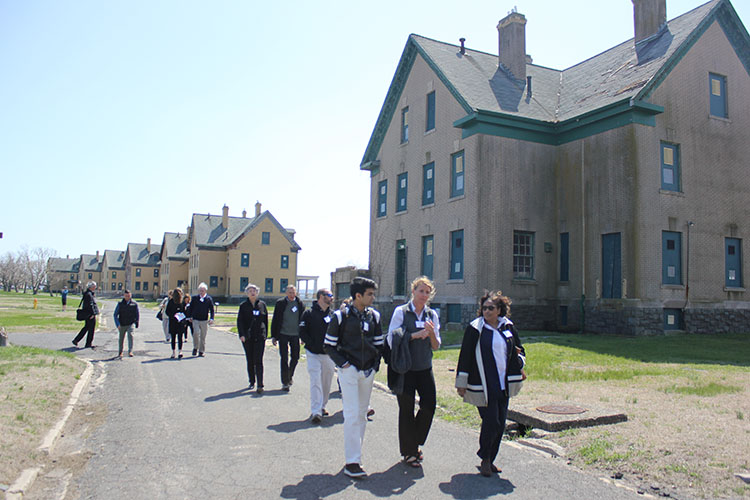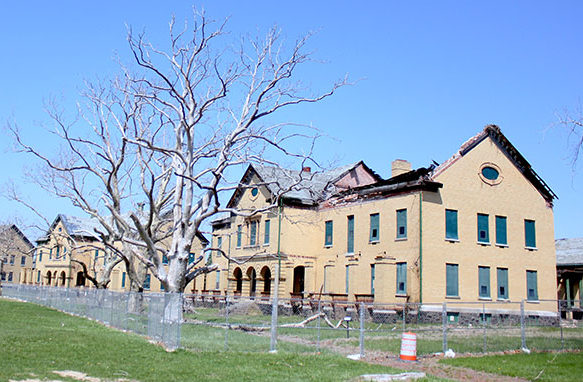By Chris Rotolo |
SANDY HOOK – According to advocates, the next great water front community at the Jersey Shore may be right here, at Fort Hancock.
Investors are once again being sought for 35 properties in need of restoration at the historic district, located at the tip of Sandy Hook, a section of Gateway National Recreation Area. A newly rejuvenated leasing program by The Fort Hancock 21st Century Federal Advisory Committee (FHFAC) is trying to reel in commercial, residential and nonprofit investors to consider the buildings for adaptive reuse.
“One of the things we decided as a committee was that we wanted this program to lead to the development of a vibrant new community,” said committee chairman Gerry Glaser. “The chance to help found a new community, on a beautiful site near the ocean, in a national park, doesn’t come around very often.”
On April 28, a tour of the scenic grounds and distinctive buildings in the Fort Monmouth Historic District was offered to members of the National Parks Conservation Association (NPCA) and the National Trust for Historic Preservation (NTHP). The group of about 30 professionals got an aesthetically pleasing glimpse of the fully restored stately History House on Officers’ Row, where they could imagine the life of a high-ranking officer and his family during World War II.
SANDY HOOK – According to advocates, the next great water front community at the Jersey Shore may be right here, at Fort Hancock.
Investors are once again being sought for 35 properties in need of restoration at the historic district, located at the tip of Sandy Hook, a section of Gateway National Recreation Area. A newly rejuvenated leasing program by The Fort Hancock 21st Century Federal Advisory Committee (FHFAC) is trying to reel in commercial, residential and nonprofit investors to consider the buildings for adaptive reuse.
“One of the things we decided as a committee was that we wanted this program to lead to the development of a vibrant new community,” said committee chairman Gerry Glaser. “The chance to help found a new community, on a beautiful site near the ocean, in a national park, doesn’t come around very often.”
On April 28, a tour of the scenic grounds and distinctive buildings in the Fort Monmouth Historic District was offered to members of the National Parks Conservation Association (NPCA) and the National Trust for Historic Preservation (NTHP). The group of about 30 professionals got an aesthetically pleasing glimpse of the fully restored stately History House on Officers’ Row, where they could imagine the life of a high-ranking officer and his family during World War II.
“These parks have a wonderful way of bringing things to life when you can’t imagine them to be any other way,” said Lauren Cosgrove, NPCA Nor theast program manager.
 But History House is the exception to the rule on Officers’ Row, as 16 of the 18 homes overlooking the bay sit in a state of dilapidation, their interiors worn away by time and exposure to elements, including the ravaging assault by Super Storm Sandy in 2012.
But History House is the exception to the rule on Officers’ Row, as 16 of the 18 homes overlooking the bay sit in a state of dilapidation, their interiors worn away by time and exposure to elements, including the ravaging assault by Super Storm Sandy in 2012.
“The high watermark at our Coast Guard station was 13 feet 3 inches, and was even higher at other points on the Hook,” said Pete McCar thy, Sandy Hook Unit manager for the National Park Service. “And that measurement is above the mean high tide, which is actually terrifying,” he added.
 But History House is the exception to the rule on Officers’ Row, as 16 of the 18 homes overlooking the bay sit in a state of dilapidation, their interiors worn away by time and exposure to elements, including the ravaging assault by Super Storm Sandy in 2012.
But History House is the exception to the rule on Officers’ Row, as 16 of the 18 homes overlooking the bay sit in a state of dilapidation, their interiors worn away by time and exposure to elements, including the ravaging assault by Super Storm Sandy in 2012.“The high watermark at our Coast Guard station was 13 feet 3 inches, and was even higher at other points on the Hook,” said Pete McCar thy, Sandy Hook Unit manager for the National Park Service. “And that measurement is above the mean high tide, which is actually terrifying,” he added.
But on Officers’ Row the water mostly remained in the basements of those buildings, and the structures have potential. “The front porches took a bit of a beating because of the waves coming off the bay, but a little bit of occupation and maintenance goes a long way with these structures,” McCarthy said.
Occupation of the buildings is the advisory committee’s mission, established in 2012. Inclusivity matters a lot too for the advisory committee, which is why the committee tapped local residents to indicate what they would like to see housed on the grounds.
Occupation of the buildings is the advisory committee’s mission, established in 2012. Inclusivity matters a lot too for the advisory committee, which is why the committee tapped local residents to indicate what they would like to see housed on the grounds.
“The idea for this new effort was to engage in as much community participation as possible, and that’s led to discussions about what types of uses the community would like to see out there. We took all of those comments into consideration,” Glaser said.
The survey led the committee to formulate a zoning map of sorts in 2012, and, according to Glaser, this effort has resulted in one signed contract – Building 21 on Officers’ Row, which was leased in 2016 and turned into a year-round vacation rental. Nearly a dozen “expressions of interest,” or letters submitted by potential lessees and accepted by the U.S. National Park Service, have also been submitted that describe potential development plans.
The survey led the committee to formulate a zoning map of sorts in 2012, and, according to Glaser, this effort has resulted in one signed contract – Building 21 on Officers’ Row, which was leased in 2016 and turned into a year-round vacation rental. Nearly a dozen “expressions of interest,” or letters submitted by potential lessees and accepted by the U.S. National Park Service, have also been submitted that describe potential development plans.
This initiative has also granted the Marine Academy of Science and Technology (MAST) a chance to expand its campus. The career academy announced on May 4 that it had been approved to lease historical Buildings 23 and 56 thanks to a $2.9 million authorization by the Monmouth County Board of School Estimates to advance the first phases of bidding and construction.
These will be the 10th and 11th buildings leased by MAST at Fort Hancock. Proposed development plans indicate that Building 23, a former military barracks, will be used as a gymnasium and indoor drill area, and will house four classrooms and offices. Building 56 is expected to be used mainly for storage.
The budgeted funding is included in an overall tax levy that the county establishes to finance all schools in the Monmouth County Board of Education’s Vocational School District.
 “If you look at Building 23 right now, you’ll see that the roof has completely collapsed,” Glaser said. “But if a building like that can be rehabilitated, when other investors see that result and see a success story, I think that will go a long way for the rest of the properties.”
“If you look at Building 23 right now, you’ll see that the roof has completely collapsed,” Glaser said. “But if a building like that can be rehabilitated, when other investors see that result and see a success story, I think that will go a long way for the rest of the properties.”
These will be the 10th and 11th buildings leased by MAST at Fort Hancock. Proposed development plans indicate that Building 23, a former military barracks, will be used as a gymnasium and indoor drill area, and will house four classrooms and offices. Building 56 is expected to be used mainly for storage.
The budgeted funding is included in an overall tax levy that the county establishes to finance all schools in the Monmouth County Board of Education’s Vocational School District.
 “If you look at Building 23 right now, you’ll see that the roof has completely collapsed,” Glaser said. “But if a building like that can be rehabilitated, when other investors see that result and see a success story, I think that will go a long way for the rest of the properties.”
“If you look at Building 23 right now, you’ll see that the roof has completely collapsed,” Glaser said. “But if a building like that can be rehabilitated, when other investors see that result and see a success story, I think that will go a long way for the rest of the properties.”
It is estimated that it would take between $1 million to $1.3 million to restore a property on Officers’ Row, and for that price tag investors would receive a renewable 60-year lease.
Glaser said that other historical facilities around the fort’s parade grounds have received interest from restaurateurs and microbrewery professionals, but strict preservation standards have presented a hurdle for potential developers, including a single development group that was contracted in the late ‘90s to head a full restoration project of all historical fort properties. That effort failed.
“Confronting the historic preservation standards set by the Department of the Interior can be rigorous and complicated,” Glaser said. “It’s difficult for investors to anticipate what hurdles might arise during the restoration process. The park’s interest is to preserve the structures, but I have been urging a more lenient and cohesive effort, that I think you’ll be able to see with MAST.”
Glaser said that other historical facilities around the fort’s parade grounds have received interest from restaurateurs and microbrewery professionals, but strict preservation standards have presented a hurdle for potential developers, including a single development group that was contracted in the late ‘90s to head a full restoration project of all historical fort properties. That effort failed.
“Confronting the historic preservation standards set by the Department of the Interior can be rigorous and complicated,” Glaser said. “It’s difficult for investors to anticipate what hurdles might arise during the restoration process. The park’s interest is to preserve the structures, but I have been urging a more lenient and cohesive effort, that I think you’ll be able to see with MAST.”
This article first appeared in the May 10-17, 2018 print edition of The Two River Times.














